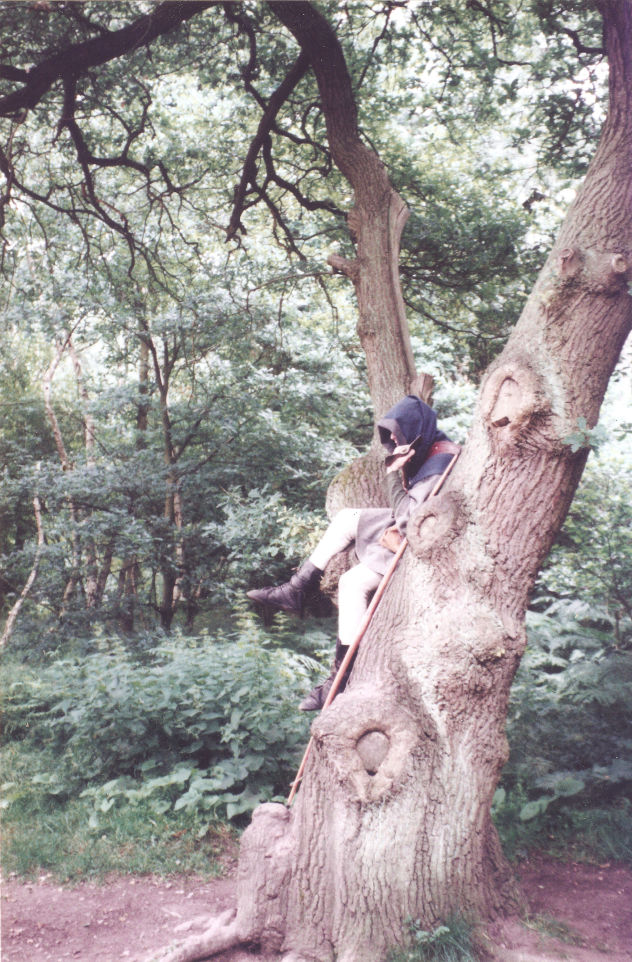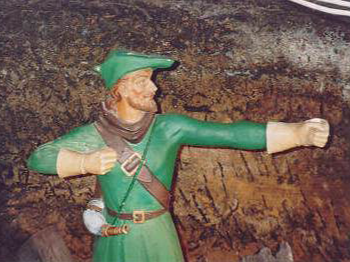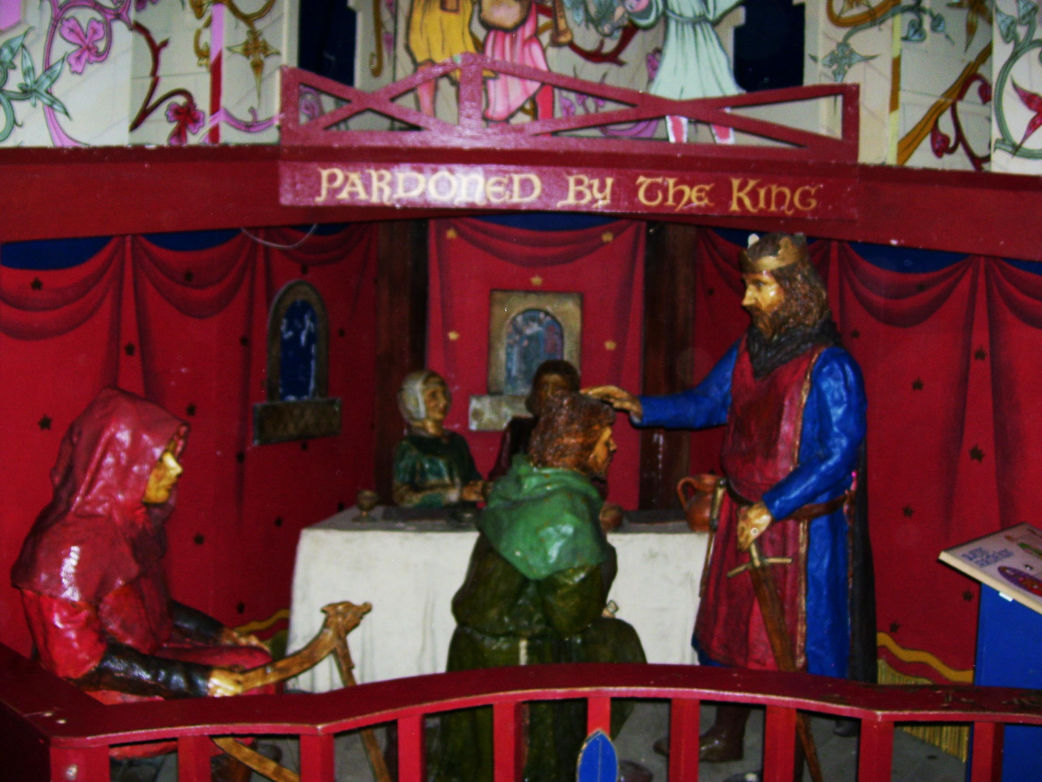Well, it's debatable if a Robin Hood that resembled the legendary character ever existed. But the idea of Robin Hood receiving a pardon from the king has been part of the tradition since one of the earliest surviving ballads.
Robin Hood receives a pardon from the king in A Gest of Robyn Hode. The story of the pardon was retold in the later ballad The King's Disguise and Friendship with Robin Hood. A similar pardoning scene has appeared in many Robin Hood books, TV shows and movies.
What distinguishes the Gest's pardoning from many of the later pardons is that Robin Hood is not happy living as a pardoned member of the king's court. After 15 months, all of his men except for Little John and Will Scathelocke have left him. Robin's spent all his money. His skill has diminished. He's broke and bored.
So Robin makes the excuse to go visit a chapel he founded in Barnsdale. The king grants him one week's leave. Once Robin's back in his greenwood haunts, Robin blows his horn and 140 of his outlaw band appear. Robin decides to spent another 22 years living in the woods as an outlaw. In this ballad, living as an outlaw is Robin's natural state.
Usually in the movies, Robin being accepted back into the court and legal society is the happy ending. Even the later versions which show Robin leaving the king's service, it's because the king has done something evil. We can see Robin Hood break with the king in 1976's Robin and Marian, the 1984 episode "The King's Fool" of Robin of Sherwood, and the 2010 Robin Hood film starring Russell Crowe.
A meeting with the king is not unique to the Robin Hood legend. For example, Mark Truesdale's 2018 book The King and Commoner Tradition: Carnivalesque Politics in Medieval and Early Modern Literature explores this trope in detail.
Robin Hood isn't even the only medieval outlaw to receive a royal pardon, even though this other story doesn't fit the king and commoner trope as well as Robin Hood's pardon. In the ballad Adam Bell, Clim of the Clough, and William of Cloudesley the queen convinces the king to pardon the three titular outlaws of past crimes. Moments later a messenger arrives to tell how the now-pardoned outlaws had previously killed 300 people in the town of Carlisle. Ooops.
So, who was the king that pardoned Robin Hood?
Well, that's where it gets a bit complicated.
The answer you are probably thinking of is Richard I (1189-1199) also known as Coeur de Lion or "The Lionheart". Richard is the king's name in the later ballad The King's Disguise and Friendship with Robin Hood. Many modern stories tell of Richard and his cruel brother John (Prince John in many tales, but he did become king in 1199 and reigned until 1216.) We'll get to those two ... eventually.
King Richard is not the king mentioned in the original Robin Hood ballad where the outlaw meets the king.
The Gest says that the king who pardoned Robin Hood was named "Edwarde, our comly kynge." But which Edward is that?
Stephen Knight has argued it could be Edward IV (1461 - 1470 and 1471 - 1483 - with a brief period in 1470 where his predecessor Henry VI reclaimed the throne). Edward IV was possibly on the throne when the Gest was compiled into its present form.
But a more heroic and romanticized King Edward would have been King Edward III (1327 - 1377). This Edward would have either been on the throne or very recently died at the time of the earliest surviving literary reference to the Robin Hood legend in the 1377 edition of William Langland's Piers Plowman (the "B-text", where a character remarks he knows the rhymes of Robin Hood). Edward III is the king in other stories where commoners have encountered the king in disguise. And in one poem, this Edward is described as comely, just as the one in the Gest is.
He was also the king during the Battle of Crecy (1346), a well-regarded triumph for the English longbow over the French.
But some believers in a real Robin Hood look to Edward III's father, Edward II (1307-1327). After all, a real man named Robin Hood served in his court. (Although the connections to the legend are dubious at best.)
And then, there's Andrew of Wyntoun -- writer of the Orygynale Chronicle from around AD 1420. He places Robin Hood in the year AD 1283 -- the reign of Edward I (1272 - 1307). Perhaps it's appropriate that it was in the wars of Edward I that the longbow also figured prominently.
But another early chronicler picked a different year for Robin Hood. Writing around 1440, Walter Bower says that Robin Hood was active in 1266, the reign of Henry III (1216-1272)
And he's not the only Henry associated with Robin Hood. The ballads Robin Hood and Queen Katherine and Robin Hood's Chase appear to take place during the reign of Henry VIII (1509 - 1547) and possibly his first wife Catherine of Aragon. (Three of this king's six wives were named Catherine.) Of course this Henry lived after the Robin Hood ballads were first circulated.
Authors such as Howard Pyle -- who wrote a children's classic in 1883 -- have changed the king and queen from Henry VIII and Catherine to King Henry II (1154-1189) and Queen Eleanor of Aquitaine. One source published around 1600 says Robin was born in AD 1160, and that is Henry II's reign. Queen Eleanor outlived her husband, and she's been a supporting character in Robin Hood films and TV movies set during the reigns of her children.
Yet another early chronicler, John Major writing around AD 1520, sets Robin Hood in another king's reign Richard I (1189-1199) and with him John I (1199-1216). That's probably the setting you are most familiar with.
The Elizabethan Robin Hood plays written by Anthony Munday also took place in the reigns of King Richard and King John. Robin Hood was a supporting character,
And then there's Sir Walter Scott's 1819 novel Ivanhoe -- which was one of the most popular and influential novels of the 19th century. Robin Hood appears under the alias of Locksley and splits an arrow at the archery contest before Prince John. King Richard also appears in the novel, disgused as the Black Knight. While the novel was romanticized and exagerrated, it did draw upon genuine history for some of the background.
King Richard did not spend much time in England. Very shortly after being crowned king he left England to go on the Third Crusade. Richard gave his brother Count (or Prince) John control of six counties, Nottinghamshire among them. On the way home from the Crusade, Richard was captured by Duke Leopold of Austria and was later transferred to him to the capitivity of Henry VI, the Holy Roman Emperor. Emperor Henry demanded that England a ransom of 150,00 marks for the return of their king.
Meanwhile, John had extended his control past his allotted six counties. And he conspired with King Philip II of France to try bribe Emperor Henry into keeping Richard captive for longer. But Richard was released in February 1194. He travelled across England, and in March 1194 King Richard had to lay siege to Nottingham Castle. The castle was held by John's supporters, who may have also doubted it was truly the king who returned.
Perhaps it's due to Ivanhoe's popularity that this background was shaped and fictionalized into the background of many Robin Hood books, TV shows and movies.
In fiction King Richard the Lionheart is portrayed as a romantic hero. But more recent versions have painted a less flattering portrait of the king. In these tales, the ransom tale is almost overlooked in favour of another piece of history.
While on Crusade in 1191, King Richard took the city of Acre. Richard tried to ransom the Muslim prisoners and also exchange them for Christian prisoners. Richard's deadline was not met. So, on August 20, 1191 King Richard ordered the massacre of 2,600 prisoners on the hill of Ayyadieh.
Richard's horrific act haunts Robin Hood in several modern tellings of the legend. For example, in the 2010 film Russell Crowe's Robin Hood tells King Richard that the massacre after Acre had made Richard and the English "Godless".
Richard was a warrior. The 1938 film starring Errol Flynn ends with King Richard victorious at Nottingham in 1194 -- back safe and sound in England to dispense wise laws. But the 1984 episode of Robin of Sherwood accurately depicts Richard held a council at Nottingham where he sold the royal appointments off to the highest bidder. By May of 1194, Richard left England -- never to return. He spent the next five years fighting to regain lost territories in France.
On March 25, 1199, King Richard was struck by an arrow during a campaign against an obscure castle in Chalus, France. The wound became infected and Richard died on April 6, 1199. His death is depicted in the 1976 film Robin and Marian and also in the 2010 Robin Hood film.
In both cases, Richard's death occurs early in the films, So the rest of the tale takes place in the reign of King John.
John's reign provides many storytelling opportunities that have been exploited by Robin Hood writers. John feuded with Pope Innocent III over the appointment of the Archbishop of Canterbury. The pope placed England under Interdict between 1208 and 1213. Essentially this means the church went on strike and major church functions did not happen.
Robin and Marian depicts Robin leaving for England right after Richard's death and arriving to find that England is already under Interdict -- even though those two historical events are nine years apart. Even the supposedly realistic Robin Hood films distort history.
Then, there's the Barons Revolt. On June 15, 1215, aggrieved barons forced King John to sign a charter which upon its reissue years later would be known as the Great Charter, or to give it its more familiar Latin name -- the Magna Carta. The significance of the charter is a subject for historical debate. But many of our just laws and freedoms are depicted as having sprung from this charter.
Of course, fiction writers have inserted Robin Hood into that event too.
The 2010 film has Robin Hood leaving France for England immediately after King Richard's death, Upon his arrival, Robin is embroiled in Charter politics and a French invasion. While not quite the Magna Carta of 1215 or the 1216 invasion -- it parallels genuine historical events closely enough that it feels like it took this Robin 16 years to travel from France to England. It's yet another "realistic" version of the legend playing as fast and loose with history as the technicolor swashbuckling epics of days gone by.
So, you might be wondering why Richard and John's reigns are so tied up with lands in France. Well, this is another aspect of the Robin Hood legend that mostly comes from Sir Walter Scott's Ivanhoe.
Scott's novel depicted the tensions between the French-speaking Normans and the English Saxons. So, who were the Normans? They were originally Vikings who had settled in France and become assimilated to a degree, subjects of the French king.
In 1066 Duke William of Normandy invaded England and defeated and killed the English king Harold. William became the king of the English and installed his fellow Normans into positions of power.
When William conquered England -- the dukes of Normandy now had a dual role. For their lands in France -- they were mere dukes, subjects of the French king. But in England -- they were kings and the ruler. Between William and Richard's days, marriages and alliances had given the English rulers even more French possessions. (Most of which were lost in the reign of King John.)
Scott's depiction of Norman and Saxon tensions was highly influential. While not a notable aspect of the legend before Ivanhoe, afterwards many Robin Hood books later films and TV show would depict the ruling Norman class being prejudiced toward the English Saxons.
But these tales were set in the days of Richard I -- over a hundred years of the Norman conquest of England. So naturally some writers have shifted the Robin Hood story back to the days of William the Conqueror. (Parke Godwin's 1991 novel Sherwood is a prime example of this.
Oh, and there's yet one more king worth mentioning.
In T.H. White's novel The Sword in the Stone, book one of The Once and Future King, Robin Hood is helped by a lad nicknamed Wart. Wart's foster brother Kay came up with the nickname as a variation on the lad's true name -- Art or Arthur. As in King Arthur and the Round Table. Traditionally the Arthurian stories are set centuries before Robin Hood's day. But it should be clear by now that while fiction may borrow from history -- it is not history.



Contact Us